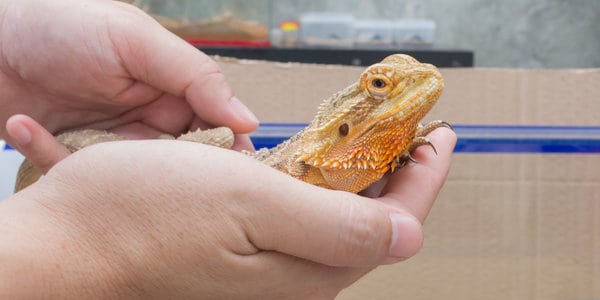Pet bearded dragon owners who smoke may wonder if beardies can get high from passive smoke. In this guide, we will cover all you need to know about bearded dragon getting high.
Can Bearded Dragons Get High?
Yes, bearded dragon can get high from secondhand smoke.
7 Signs Of A Bearded Dragon That is High
Bearded dragons can get high if they come into contact with secondhand smoke.
Bearded dragons have an identical response to cannabis in their endocannabinoid system (ECS), but they tend to have a bad experience as they have an inferior respiratory system. Beardies that inhale or ingest cannabis get high instantaneously as its body can’t handle such high doses. They exhibit these symptoms:
- Respiratory System failure
- Vomiting
- Seizures’
- drowsiness
- Possible poisoning
- Breathing problems
- Disorientation
How To Prevent Your Bearded Dragon From Getting High?
1. Correct distance
It’s advisable to smoke outside away from your pet bearded dragon to avoid the above symptoms.
Make sure that any products containing cannabis are stored safely away from the beardie’s enclosure.
They should never come into contact with secondhand smoke as it will have a worse effect on them.
2. Clothing
After smoking, you should change your clothes before handling your pet beardie. While at it, do something about your breath as well.
No need to risk your beardie inhaling the smoke. Most reptile experts recommend that you wait for at least 15 to 30 minutes after smoking before handling a bearded dragon.
Should You Be Concerned If Your Beardie Gets High?
Yes, You should be concerned if your bearded dragon gets high and immediately consult the vet. Smoking nicotine-based substances or marijuana near your bearded dragon can leave them lightheaded at best and at worst in a lethargic state that can be fatal.
Pet Bearded Dragon Common Diseases
Pet beardies are often afflicted by some diseases that exhibit similar symptoms to being high, which can cause a misdiagnosis.
To avoid such, it’s crucial to familiarize yourself with some of the common diseases that bearded dragons can contract and how to identify them and take the appropriate steps.
Most of these diseases result from negligence whereby the beardie is left in the wrong environment, fed on improper diets, and exposed to infections from other reptiles.
Metabolic Bone Disease (MBD)
Metabolic bone disease is one of the most common beardie diseases caused by nutritional imbalance. It’s primarily seen in juvenile bearded dragons that generally don’t get enough vitamin D3.
This vitamin is crucial in the uptake of calcium and phosphorus. The disease has common symptoms with highness, such as lethargy and leg tremors when the beardie tries to walk.
MBD mainly develops in bearded dragons that don’t get enough UVB exposure required for the synthesis of vitamin D in the skin cells. Some identifying symptoms include swelling of the jaw with softening facial bones and hind legs swelling up.
These symptoms are only seen towards the late stages of the disease, and you should contact the vet immediately if you notice any of them.
As the disease progresses, the beardie will tend to develop fractures on the soft bones, and they are rendered immobile as their limbs can no longer support their weight.
Respiratory Infections
When bearded dragons get stressed or left in cold and dirty conditions, they develop pneumonia and other respiratory infections.
A poor diet may also contribute to the spread of infectious bacteria and fungi that trigger respiratory infections. In some rare cases, the infection may also result from viral and parasitic infections.
Respiratory infections tend to have some common symptoms with highness, such as unnaturally shallow breathing, lethargy, decreased appetite, and sneezing.
However, the disease can be spotted with the presence of excessive thick mucus and blowing bubbles from the nose and mouth.
Adenovirus
Adenovirus is a contagious disease commonly referred to as the stargazing and wasting disease due to its symptoms.
Adenovirus primarily infects young bearded dragons, and other bacterial infections and intestinal parasites often accompany it.
The condition has common symptoms with highness, such as lethargy, slowness, and erratic movements.
ADV positive beardies also exhibit other symptoms such as arching the tail and head and seizures. Eventually, the bearded dragon will start rolling uncontrollably in the cage until death if no medical intervention is done by a vet.
Infectious Stomatitis
Infectious stomatitis is a bacterial infection that affects a beardie’s gums and jawbones. The disease has similar symptoms to highness in beardies, such as lethargy and lack of movement.
However, it can be identified through swollen jaws and thick mucus with a cottage cheese consistency.

Do Bearded Dragons Have an ECS?
Yes, bearded dragon have an endocannabinoid system (ECS). They experience the high due to their endocannabinoid system (ECS) stimulated by the THC molecules in weed.
What Happens If You Get a Beardie Too High?
Without immediate vet intervention, beardies can die if their respiratory system shuts down after getting high.
Wrap Up
Bearded dragons are some of the friendliest reptile pets, and they have an exciting personality that makes some wonder if they can get high.
Well, they may experience the effects of weed and tobacco products, but it’s harmful to them.
Avoid getting high near your beardie as it might get into contact and get ‘high’ symptoms from second-hand smoke.
If you notice that your bearded dragon is exhibiting possible symptoms of being high, you should contact the vet immediately.
